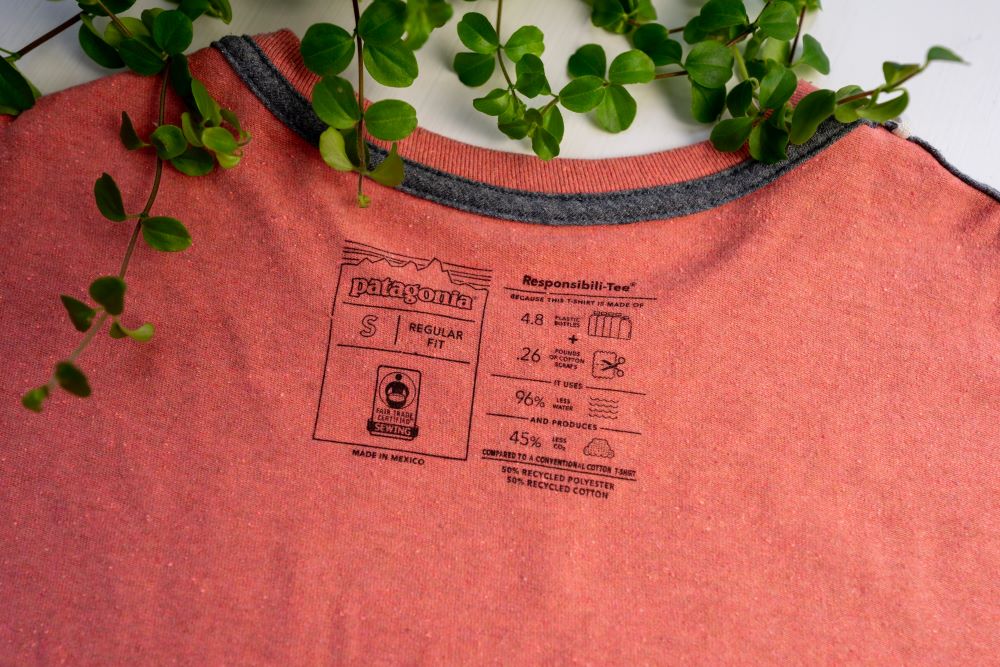Sure, there’s a climate cost for producing synthetic fibers. But there’s a climate cost for producing cotton, and for processing and transporting all fibers and finished products. In fact for everything we do and make.
It’s not the fossil fuels used to make the synthetic fibers that’s a problem.
It’s the fact that it’s plastic. Even when it’s recycled polyester fibers… it’s still plastic.
Plastic that does not biodegrade. When these fibers get worn and when they get washed tiny bits of them break off and get out into the environment. To the point where they now are found… everywhere on the surface of the earth and throughout the oceans. And in all forms of life.
Microfibers are the major marine pollutant throughout the world estimating 13 million tonnes of coastal synthetic fabric waste entering the ocean each year, out of which 2.5 million tonnes enter through adjoining rivers
Pubmed
Beware the greenwashed recycled fibers
Recycling has long been an answer to filling landfills, reducing resource consumption, and lowering energy consumption. It’s best for the environment.
But when it comes to recycled fibers for clothing and other textiles, this simply doesn’t apply.
The PET (polyester) that many plastic bottles are made of is good for recycling at least 10 times over before their quality is diminished. The recycling stream for them is now established, although only 29.1% of PET bottles got recycled in 2017.
But now some of that PET is being diverted from recycling into bottles to recycling into fibers instead, to make recycled polyester (rPET) fibers. Polyester comprises 52% of all fibers used today.
So this means some of the bottles the recycling industry is set up to handle get diverted to make more clothing that… sheds more microfibers. That ends the recyclability of those bottles .
Recycled polyester (rPET) makes fashion brands look good. Because, it makes you feel like you are helping remove plastic waste from the environment. And emitting less greenhouse gas.
But recycling polyester (and any other synthetic textile fiber) turns it into more fibers that shed. More microplastics. More microfibers. The very fibers and plastic bits that are coating the surface of the earth and getting into all waterways, polluting the oceans, and wreaking havoc on all marine life.
All tiny bits of plastic and plastic fibers are harmful to life. And there’s already so much in the ocean and all around us.
Here’s what brands are saying about their recycled plastic fibers
“So, Why Choose Recycled Clothing?
When it comes to sustainable fibers, recycled fibers are the undisputed gold standard. Virgin materials require huge amounts of land, water, energy and chemicals. Every year, 12.8 million tons of textiles end up in US landfills. Our goal is to lessen the impact by using recycled fibers. In 2019 alone, we spared 25 tons of reusable material from entering the landfill, 20 million gallons of water, and the equivalent CO2 emissions of driving 300,000 miles by using recycled wool, recycled cotton and recycled polyester. The future is recycled.”
Toad & Company
I do love their clothing, the 100% cotton ones. I have a beautiful all cotton dress from them.
I definitely agree with using recycled wool and cotton, but I definitely do not agree with using recycled polyester.
In fact the picture on the left on their page with this quote, shows a woman with a thick fleece vest. The kind of fleece fabric that sheds the most microfibers when wearing and washing.
And from REI (one of my favorites for outdoor clothing and gear), is this article from their “Expert Advice” section: Understanding Recycled Materials in Outdoor Clothing & Gear where they applaud the “success” of recycling polyester from plastic bottles.
I think they didn’t realized that recycling takes a recyclable item out of its recycling stream and turns it into a microfiber shedder.
This shows that many don’t think the problem through.
It’s complicated, unfortunately. But it’s important to know the truth about things so you can make the right decisions. To help our planet.
What about recycling clothing?
We’re a long way from recycling synthetic fibers from clothing. As of 2021 less than 1% of clothing was recycled. And that’s because it’s a very difficult process. Often, the synthetic fiber, usually polyester, is blended with natural fibers like cotton or other synthetics like elastane. Separating them is difficult!
People are working on it, but… the scale at which we need it is enormous.
There are chemical processes and there are mechanical processes to separate fibers. Both chemical and mechanical plastic fiber recycling involves energy and pollution. A lot of energy. In the processing plant, the fibers can escape into the air, possibly into the water…
The chemical process would require… chemicals. And the disposal and volatility of these chemicals sounds to me like an environmental problem and a health problem for workers.
The mechanical process could release large amounts of synthetic fibers and microfibers just from their manipulation.
Here’s what Lucianne Tonti writes in The Guardian’s “How green are your leggings? Recycled polyester is not a silver bullet (yet)”:
“…is polyester something we should be wearing at all? It’s a plastic, it’s a breeding ground for the bacteria that causes body odour, and unlike natural fibres it doesn’t breathe.”
To which co-founder and president of EVRNU, Christopher Stanev replied, “polyester is an unnatural fibre, it’s not biodegradable, it is bio-accumulative. If we need to recycle it, we can, but it’s not a good application to be used in fibres. Maybe [we can use it] in construction, cars, things we can recover that don’t leak into the water systems.”

There’s a very simple solution
Skip the synthetics. Period.
Natural fibers are better for the earth, plain and simple.
And for our bodies.
Wool is the most reused fiber. It’s better than all the others at thermoregulating our bodies; keeping us warm in winter and cooler when it’s hot. It has a very low stink factor, and needs less washing than synthetics. It’s fibers are biodegradable when they’re shed in the wash and when we wear them.
To top it off, wool can be produced and processed using regenerative practices that actually benefit the earth!!!
Cotton is comfortable. It’s breathable. Looks good. It doesn’t pill or snag. It, too, has a low stink factor, so you can get away with less washing. And regeneratively grown cotton is also beneficial to the earth!
Then there’s linen, silk, hemp, and others.
Some textile makers are using plant dyes in their fibers, which means you can compost your garments when they’re really worn out. You can wear them to the bitter end and compost them.
Buying quality clothing and making them last reduces each individual’s fashion footprint. Choose natural fibers, they’re better all around. Care for them well. Pass them along when you no longer need or want them. Shop second hand for some of your purchases.
Avoid recycled plastic fibers
- Recycling is very important, just not in this case.

- Natural fibers are the most eco-friendly.
- Fibers made from recycled plastic bottles removes the bottles from their recyclability and creates a material that more readily disperses microfibers throughout the environment, creating perhaps the most destructive form of plastic pollution in the ocean.
- Recycling synthetic fibers from clothing simply perpetuates their impact on life on this earth
What to do with your synthetic fabrics?
I think synthetic fabrics should go into a plastic bag (a used one) and put into the landfill. Where they’ll hopefully stay concealed and off the surface of the earth.
Yes, that means treating them like hazardous waste.
Related Reading:
Just Stop Wearing Plastic Clothes!
How to Reduce Plastic Microfibers from Your Laundry Wastewater
Wool IS an Eco-Friendly Fiber–You Just Need to Choose it Well
Is Cotton Bad for the Environment?
What are microfibers? Where do they come from? Why are they a problem?
Microplastic: The Most Insidious Plastic Problem
Septic Systems Keep Microfibers Out of the Environment, Right?


Nonsense
Hi, I’m sorry you think that. Could you explain why you think that?
What a great topic
Thank you, I know it’s a surprise for many people.
I used to think differently, thanks for the explanation.
You’re welcome! 🙂
I don’t know about the others, but I liked it.
I’m happy to hear that.